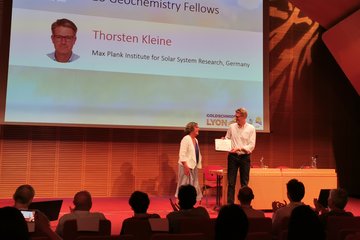Alle Typen
181.
Vortrag
Magnetic fields and currents at Mars and Venus. AGU Chapman Conference "Currents in Geospace and Beyond", Dubrovnik, Croatia (2016)
182.
Vortrag
Effects of solar irradiance on the upper ionosphere and ion fluxes at Mars, Mars Express and MAVEN observations. 8th MUAN meeting, Leicester, UK (2016)
183.
Vortrag
Coherent large-amplitude waves in the Martian plasma environment. 1st URSI Atlantic Radio Science Conference, Gran Canaria, Spain (2015)
184.
Vortrag
Cold Ion Escape from the Martian Ionosphere. European Planetary Science Congress, Nantes, France (2015)
185.
Vortrag
Phobos-solar wind interaction: Results from Mars Express for the closest-ever fly-by. European Geosciences Union General Assembly 2014, Vienna, Austria (2014)
186.
Vortrag
Large-amplitude coherent structures in plasma near Mars. The 5th Moscow Solar System Symposium (5M-S3), Moscow, Russia (2014)
187.
Vortrag
Ionospheric magnetic fields and currents at Venus and Mars. European Geosciences Union General Assembly 2014, Vienna, Austria (2014)
188.
Vortrag
Ionospheric magnetic fields at Venus and Mars and their effect on plasma flow in the near planet wakes. EPSC, Estoril, Portugal (2014)
189.
Vortrag
Asymmetrical response of the ionospheric magnetization and the plasma sheet formation on the IMF orientation. 6th Alfven Conference: Plasma Interactions with Solar System Objects anticipating Rosetta, MAVEN and Mars Orbiter Mission, London, UK (2014)
190.
Vortrag
Ablation of Venusian oxygen ions by unshocked solar wind. European Geosciences Union General Assembly 2014, Vienna, Austria (2014)
191.
Poster
Efficiency of Solar wind electric field in accelerating planetary ions. EPSC-DPS Joint Meeting 2019, Geneva, Switzerland (2019)
192.
Poster
Mars in the Solar Wind - Simulations and Observations. EPSC-DPS Joint Meeting 2019, Geneva, Switzerland (2019)
193.
Poster
Reduced Atmospheric Ion Escape Above Martian Crustal Magnetic Fields. 21st EGU General Assembly, EGU2019, Vienna, Austria (2019)
194.
Poster
Mars in the Solar Wind. 21st EGU General Assembly, EGU2019, Vienna, Austria (2019)
195.
Poster
An induced global magnetic field looping around the magnetotail of Venus. European Geosciences Union General Assembly, Vienna, Austria (2016)
196.
Poster
Plasma acceleration in the Martian magnetotail. European Geosciences Union General Assembly, Vienna, Austria (2016)
197.
Poster
EUV0dependence of Venusian ionopause height over the dayside high-latitude region: VEX and PVO observations. European Geosciences Union General Assembly, Vienna, Austria (2016)
198.
Poster
Ionosphere of Mars as seen by Mars Express. Effect of crustal fields. European Planetary Science Congress, Nantes, France (2015)
199.
Poster
Cold Ion Escape from the Martian Ionosphere - 2007-2014. European Geosciences Union General Assembly, Vienna, Austria (2015)
200.
Poster
Seasonal Variation of Martian pickup ions. European Planetary Science Congress, Nantes, France (2015)











